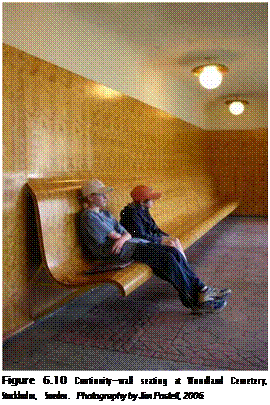 The wall-mounted wood paneling that transforms into a sinusoidal bench in Gunnar Asplund’s chapel at the Woodland Cemetery in Stockholm, Sweden, expresses continuity, unity, and variety. The panels are evenly modulated and create a datum (unifying reference) from which the sinusoidal bench gives variety to the otherwise rectangular elements and planar surfaces. The uninterrupted plane of the laminated plywood gives continuity, and the integration of wall and furniture in material and form gives unity to the design (Figure 6.10). Unity and continuity underscore fundamental principles of design that draw together part-to-whole relationships.
The wall-mounted wood paneling that transforms into a sinusoidal bench in Gunnar Asplund’s chapel at the Woodland Cemetery in Stockholm, Sweden, expresses continuity, unity, and variety. The panels are evenly modulated and create a datum (unifying reference) from which the sinusoidal bench gives variety to the otherwise rectangular elements and planar surfaces. The uninterrupted plane of the laminated plywood gives continuity, and the integration of wall and furniture in material and form gives unity to the design (Figure 6.10). Unity and continuity underscore fundamental principles of design that draw together part-to-whole relationships.
Variation is expressed through differences and distinctions perceived within the bounds of constancy and regularity. The regularity of the vertical supports in Charles and Ray Eames’s Eames Storage Unit (ESU) expresses continuity (see Chapter 4). The supports establish a repeatable pattern, while the lacquered Masonite panels give variation to the design through their placement and color. Unity is achieved in the dynamic interplay between the unit’s components and its geometric order.



